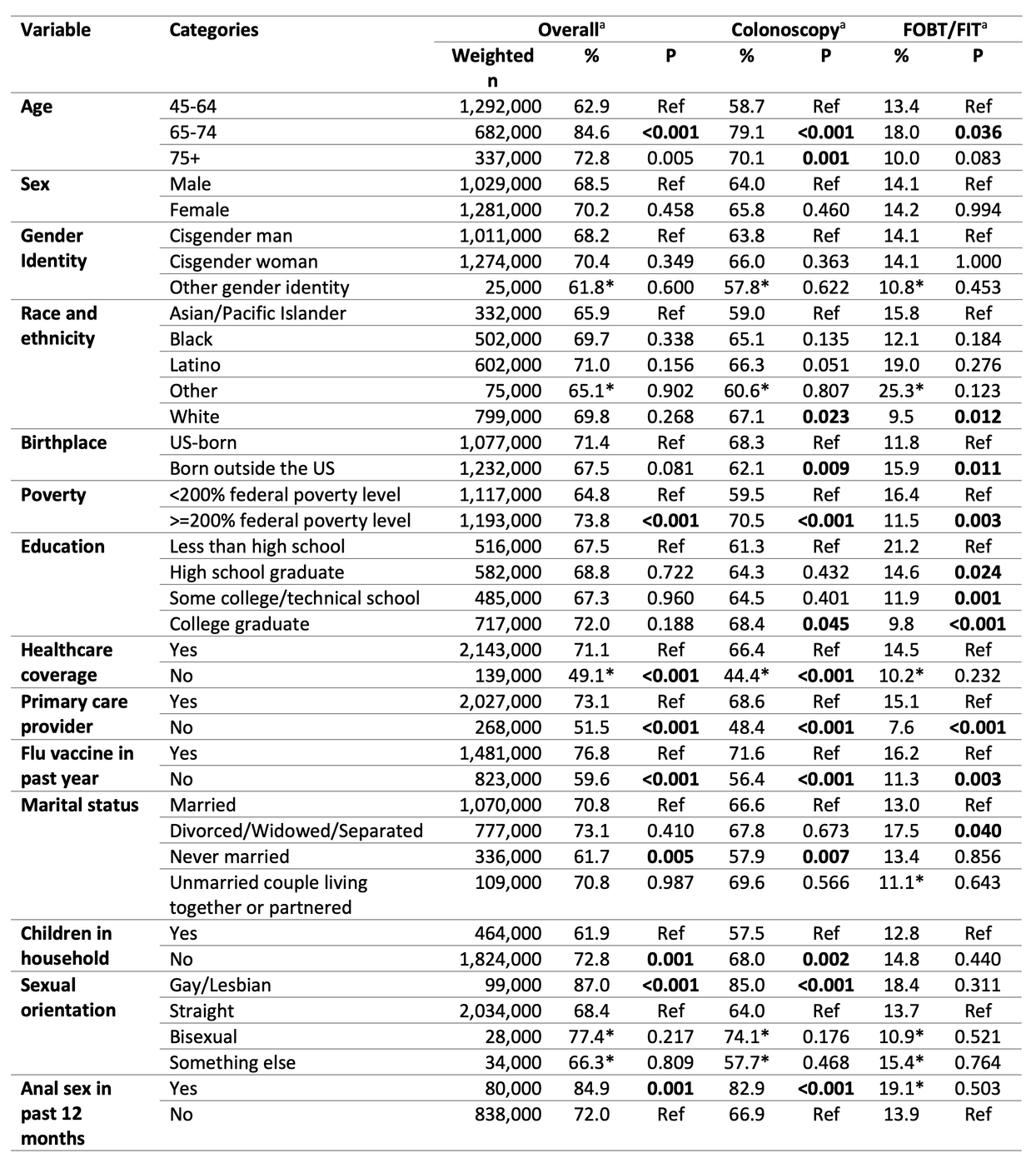Tuesday Poster Session
Category: Colorectal Cancer Prevention
P4785 - Colorectal Cancer Screening Uptake in New York City: An Analysis of the 2021-2023 Community Health Survey
Tuesday, October 28, 2025
10:30 AM - 4:00 PM PDT
Location: Exhibit Hall

Abraham Zachary Cheloff, MD, MS (he/him/his)
NYU Langone Health
New York, NY
Presenting Author(s)
Abraham Zachary. Cheloff, MD, MS1, Cynthia Anderson, MPH2, Trisha Williams, 2, Nneka Lundy De La Cruz, MPH2, Peter S. Liang, MD, MPH1
1NYU Langone Health, New York, NY; 2NYC Department of Health and Mental Hygiene, New York, NY
Introduction: The New York City Community Health Survey (CHS) is a population level cross-sectional survey in the largest and most diverse city in the US. It has previously been used to measure colorectal cancer (CRC) screening by colonoscopy among those aged 50+ years. We present updated screening data that captures fecal occult blood test/fecal immunochemical test (FOBT/FIT) as well as colonoscopy use in the age 45+ population.
Methods: We extracted data from the 2021-2023 CHS, weighted to the adult residential population per the American Community Survey and age-adjusted to the US 2000 Standard Population during analysis. Up-to-date screening was self-reported and defined as colonoscopy within the past 10 years or FOBT/FIT within the past year.
Results: Up-to-date CRC screening in NYC increased from 63.9% in 2021 to 69.2% in 2023 (P=0.001), with similar improvements in colonoscopy (60.9% to 64.9%, P=0.014) and FOBT/FIT (11.1% to 14.0%, P=0.014) uptake. In 2023, individuals aged 65-74 had higher screening than those aged 45-64 overall (84.6% vs. 62.9%, P< 0.001), by colonoscopy (79.1% vs 58.7%, P< 0.001), and by FOBT/FIT (18.0% vs. 13.4%, P=0.04). Consistently higher screening was also observed for those with a primary care provider and who received a flu vaccine in the past year (Table). Overall and colonoscopy screening were higher for individuals who were married vs. never married, gay/lesbian vs. straight, had healthcare coverage, had no children in the household, had excellent vs. poor health, and engaged in anal sex. Notably, colonoscopy and FOBT/FIT uptake differed for several variables. Compared to White individuals, Asian/Pacific Islander individuals had lower colonoscopy (67.1% vs 59.0%, P=0.02) but higher FOBT/FIT (9.5% vs. 15.8%, P=0.01) use, with no difference in overall screening rates (69.8% vs 65.9%, P=0.27). Higher colonoscopy but lower FOBT/FIT uptake was also observed for individuals who were US-born, more affluent, and college graduates vs. those who did not complete high school. There were no differences by sex, gender identify, borough of residence, employment status, or body mass index.
Discussion: CRC screening in NYC has continued to improve overall, but disparities persist in the younger, poorer, less educated, and uninsured populations. While it’s unclear whether the differential uptake for colonoscopy and FOBT/FIT in some groups are related to access or preference, offering a choice in screening options may improve overall uptake.

Figure: Up-to-date CRC screening in NYC by modality and select characteristics, 2023
a Up-to-date CRC screening defined as colonoscopy in past 10 years, FOBT/FIT in past year, or either (overall)
* Estimate should be interpreted with caution. Estimate’s relative standard error is greater than 30%—or the 95% confidence interval half-width is greater than 10 or the sample size is too small—making the estimate potentially unreliable.
Disclosures:
Abraham Cheloff indicated no relevant financial relationships.
Cynthia Anderson indicated no relevant financial relationships.
Trisha Williams indicated no relevant financial relationships.
Nneka Lundy De La Cruz indicated no relevant financial relationships.
Peter Liang: Freenome – Grant/Research Support. Guardant Health – Advisory Committee/Board Member. Natera – Advisory Committee/Board Member.
Abraham Zachary. Cheloff, MD, MS1, Cynthia Anderson, MPH2, Trisha Williams, 2, Nneka Lundy De La Cruz, MPH2, Peter S. Liang, MD, MPH1. P4785 - Colorectal Cancer Screening Uptake in New York City: An Analysis of the 2021-2023 Community Health Survey, ACG 2025 Annual Scientific Meeting Abstracts. Phoenix, AZ: American College of Gastroenterology.
1NYU Langone Health, New York, NY; 2NYC Department of Health and Mental Hygiene, New York, NY
Introduction: The New York City Community Health Survey (CHS) is a population level cross-sectional survey in the largest and most diverse city in the US. It has previously been used to measure colorectal cancer (CRC) screening by colonoscopy among those aged 50+ years. We present updated screening data that captures fecal occult blood test/fecal immunochemical test (FOBT/FIT) as well as colonoscopy use in the age 45+ population.
Methods: We extracted data from the 2021-2023 CHS, weighted to the adult residential population per the American Community Survey and age-adjusted to the US 2000 Standard Population during analysis. Up-to-date screening was self-reported and defined as colonoscopy within the past 10 years or FOBT/FIT within the past year.
Results: Up-to-date CRC screening in NYC increased from 63.9% in 2021 to 69.2% in 2023 (P=0.001), with similar improvements in colonoscopy (60.9% to 64.9%, P=0.014) and FOBT/FIT (11.1% to 14.0%, P=0.014) uptake. In 2023, individuals aged 65-74 had higher screening than those aged 45-64 overall (84.6% vs. 62.9%, P< 0.001), by colonoscopy (79.1% vs 58.7%, P< 0.001), and by FOBT/FIT (18.0% vs. 13.4%, P=0.04). Consistently higher screening was also observed for those with a primary care provider and who received a flu vaccine in the past year (Table). Overall and colonoscopy screening were higher for individuals who were married vs. never married, gay/lesbian vs. straight, had healthcare coverage, had no children in the household, had excellent vs. poor health, and engaged in anal sex. Notably, colonoscopy and FOBT/FIT uptake differed for several variables. Compared to White individuals, Asian/Pacific Islander individuals had lower colonoscopy (67.1% vs 59.0%, P=0.02) but higher FOBT/FIT (9.5% vs. 15.8%, P=0.01) use, with no difference in overall screening rates (69.8% vs 65.9%, P=0.27). Higher colonoscopy but lower FOBT/FIT uptake was also observed for individuals who were US-born, more affluent, and college graduates vs. those who did not complete high school. There were no differences by sex, gender identify, borough of residence, employment status, or body mass index.
Discussion: CRC screening in NYC has continued to improve overall, but disparities persist in the younger, poorer, less educated, and uninsured populations. While it’s unclear whether the differential uptake for colonoscopy and FOBT/FIT in some groups are related to access or preference, offering a choice in screening options may improve overall uptake.

Figure: Up-to-date CRC screening in NYC by modality and select characteristics, 2023
a Up-to-date CRC screening defined as colonoscopy in past 10 years, FOBT/FIT in past year, or either (overall)
* Estimate should be interpreted with caution. Estimate’s relative standard error is greater than 30%—or the 95% confidence interval half-width is greater than 10 or the sample size is too small—making the estimate potentially unreliable.
Disclosures:
Abraham Cheloff indicated no relevant financial relationships.
Cynthia Anderson indicated no relevant financial relationships.
Trisha Williams indicated no relevant financial relationships.
Nneka Lundy De La Cruz indicated no relevant financial relationships.
Peter Liang: Freenome – Grant/Research Support. Guardant Health – Advisory Committee/Board Member. Natera – Advisory Committee/Board Member.
Abraham Zachary. Cheloff, MD, MS1, Cynthia Anderson, MPH2, Trisha Williams, 2, Nneka Lundy De La Cruz, MPH2, Peter S. Liang, MD, MPH1. P4785 - Colorectal Cancer Screening Uptake in New York City: An Analysis of the 2021-2023 Community Health Survey, ACG 2025 Annual Scientific Meeting Abstracts. Phoenix, AZ: American College of Gastroenterology.
